The Lincoln vs. the Howard: What a difference operations make

The revival of the Howard Theatre brought worry that our newly revived venue would follow the disappointing path of the Lincoln Theatre on U Street. After all, both theaters were built in the early 20th century, both are owned by the DC government, and both are located within a short walk of each other.
A glance at both theaters’ online schedules reveals that their fates have sharply diverged. From now until the end of June, the Lincoln Theatre has 5 events scheduled while the Howard has 51.
This glaring disparity shows the importance of selecting the right management team. The District chose the experienced Blue Note Entertainment Group to run the Howard while it chose the non-profit U Street Theatre Foundation to run the Lincoln. The mayor’s office rightly revoked U Street Theatre Foundation’s contract for the Lincoln as the theatre was careening toward bankruptcy at the end of 2011. The mayor has tasked the DC Commission on the Arts and Humanities with finding a new operator for the Lincoln.
The greater U Street area is a regional arts venue. The Howard Theatre, the 9:30 Club, U Street Music Hall, the Black Cat, Bohemian Caverns, Twins Jazz Club, and numerous performance-oriented bars provide an amount of live performance space most cities would envy. But when we compare the success of these venues to the fiasco of the Lincoln Theatre, it becomes clear that something is terribly wrong in the District’s stewardship of this resource. If all of these venues can thrive, so can the Lincoln.
The Howard is open!
Last night the Howard Theatre held its grand opening concert featuring the musical talents of Trombone Shorty and the eminent George Clinton. After a 30-year hiatus, the century-old historic theater’s comeback has left everyone gobsmacked.
The interior is beautiful, featuring walnut panelling, tasteful lighting, and blown up shots of famous performers who made their names at the Howard. The lower floor is mostly an open concert floor, with booths and a bar on an elevated perimeter. The balcony level features a long bar, numerous tables, and banquettes that provide an superb view of the stage. Of all the articles we’ve read online, Brightest Young Things has the best photos of the interior.
The Howard’s schedule is packed with a variety of acts and with its location just a short walk from home, you have every reason to visit.
City Paper contrasts the Howard and the Lincoln
We wrote before about how the Howard Theatre differs significantly from the often-dark Lincoln Theatre on U Street. Now the City Paper published a longer essay contrasting the theaters and showing that the Howard will not repeat the mistakes of the Lincoln. According to the City Paper, there are six main reasons that the Howard will likely succeed where the Lincoln failed:
- The Howard will book a variety of popular acts, including acts that typically perform elsewhere.
- A professional management company with a history of running music clubs will manage the theater.
- The Howard can convert from a standing-room venue to a seated supper club in a flash. The Lincoln Theater’s seats, by contrast, cannot be removed.
- The Howard will serve much more food and, more importantly, alcohol, which is where profits are made in the restaurant business.
- The District government, though holding title to the property, has little influence in its operations.
- The Howard has better developed PR and marketing strategy.
Neighbors reminisce about the Howard Theatre
 In preparation for the Monday’s grand (re)opening of the Howard Theatre, the Post ran a story about the theater’s past and how the Shaw and LeDroit Park have changed over the decades since the theater’s heyday.
In preparation for the Monday’s grand (re)opening of the Howard Theatre, the Post ran a story about the theater’s past and how the Shaw and LeDroit Park have changed over the decades since the theater’s heyday.
The article also describes the histories of some long-time local businesses, including the Hall Brothers Funeral Home, the HJM Variety Shop, and Gregg’s Barber Shop.
A neighbor we know who studies local history likes to ask long-time residents if they feel the city has lost anything with the influx of residents, wealth, and investment over the past 15 years. Inevitably, the answer is yes and the answers differ to some degree.
The Post article is striking in that the residents who remember the theater in its golden age don’t expect its current incarnation to live up to the excitement of its younger self.
For those Washingtonians, the Howard’s rebirth stirs a mix of curiosity and excitement for what is new, and nostalgia and melancholy for what has been lost.
“It looks like a mausoleum to me,” said Juan Rosebar, 61, eyeing the theater on a recent afternoon, as workers laid cobblestones on the street outside.
As a kid, Rosebar watched the stars migrate from the Howard to Cecilia’s Stage Door, a bar a few yards away where they’d mix with their fans and drink post-performance cocktails. Cecilia’s closed long ago, as did Jimmy’s Golden Cue, the pool hall across the street where Rosebar learned to hustle. All that’s left is Jimmy’s rusted sign, the letters barely legible.
“You can’t turn the clock back,” Rosebar said. “You won’t get the scene; you won’t get the flamboyance.”
Another resident, Frank Love, concurs:
“It’s all changed around here,” said Love, 77, shaving a customer’s sideburns and listing the names of a half dozen long-gone barbershops. He can’t wait for the Howard’s reopening and the chance to step inside the place where he went to see Jackie Wilson with his future wife, Pearl Love.
He knows the theater can’t be what it was, but he’s okay with that. “That was then, and this is now,” he said. “You can’t look for it to be the same.”
You can tell from the posts on this blog that history fascinates us. However, the study of history is part real and part imagined. Though buildings can be preserved and restored, the people and societies that made them relevant cannot. The Howard will reopen on Monday and it will serve as a lively venue for a diverse array of national acts, but its cultural relevance may never again match its storied past.
Duke Ellington immortalized in stainless steel
The Howard Theatre is nearly complete. You may have noticed that the sidewalk on the north side of T Street is now open, giving residents a close-up view of the new façade. More importantly, the plaza at T Street and Florida Avenue is now open and the new sculpture of Duke Ellington stands prominently at the vegetated plaza. The sculpture depicts Ellington seated on a treble clef while playing a piano keyboard.
The most delightful feature of the sculpture is the energy it portrays. As Ellington plays, the keys appear to fly off the keyboard and into the sky behind him, signifying a magical quality to his music.
Duke Ellington grew up in Washington and even lived on Elm Street in LeDroit Park for a year. He played at the Howard Theatre and frequently visited the adjacent Frank Holliday’s pool hall, most recently known as Cafe Mawonaj.
The hall was a popular gathering spot for Howard scholars, jazz musicians, and city laborers alike. Duke Ellington captured the scene at the pool hall:
Guys from all walks of life seemed to converge there: school kids over and under sixteen; college students and graduates, some starting out in law and medicine and science; and lots of Pullman porters and dining-car waiters.
And now Ellington’s statue sits on the same storied block.
Florida Avenue project advances slightly
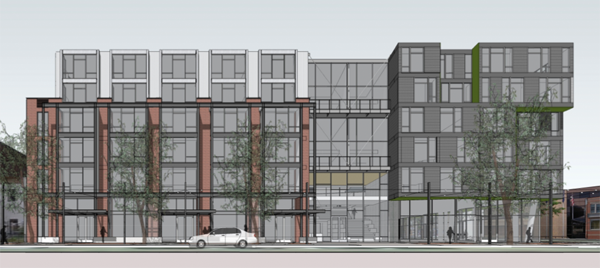
The JBG apartment project on the 700 and 800 blocks of Florida Avenue NW moved forward last week when the Historic Preservation Review Board (HPRB) gave partial approval to the project. The modernist design will likely have to endure a few more refinements before the board grants its final approval for the site.
Building alterations, additions, demolitions, and construction in historic districts are subject to review by the Historic Preservation Review Board. Since the site sits in the U Street Historic District, it must also gain HPRB approval before it can receive building permits.
Though we are supporters of historic preservation, we can see why this extra level of review frustrates builders and property owners. The main problem is that historic review requires property owners, architects, and developers to adjust their designs based on subjective judgments of historic compatibility.
The historic review process is less predictable that the typical building process, which simply requires that a builder meet unambiguous zoning regulations and building codes. For instance, the JBG site is zoned C-2-B, which permits residential projects to rise to 65 feet or to rise to 70 feet if they include affordable housing.
Distances are easy and unambiguous measurements, but how does one determine if a proposed design is historically compatible?
As in most cases where subjectivity needs analysis, you can easily define the extreme cases. The Weaver Building (HUD’s headquarters) is undoubtedly incompatible with the Victorian rowhouse architecture of the U Street area. Likewise, a good number of preservationists despise projects that attempt precise replication of historic structures. The right answers lies somewhere between aping historic forms and shunnig them all together.
For its Florida Avenue sites JBG project solicited design proposals from architecture firms nationwide. The winner, Seattle-based Miller Hull, designed a truly modernist project.
Modernism, a 20th century invention, can work well in historic districts if done right and Miller Hull has worked to refine its designs to pass HPRB muster.
Though the HPRB asked for further refinement that will have to go to the board again, the board did support the design on six features so far:
- Relocation of the front, original section of 1933-35 9th Street to the southern portion of the site, adjacent to the row of similarly-sized and scaled historic buildings, and removal of the later rear additions
- Reconfiguration of the alley on the western parcel to exit on 9th Street
- Subdivision to allow lot combination on both the west and east sites
- Overall site organization of the new construction
- Height and massing along Florida Avenue
- General architectural direction, subject to further development and material selection.
Here are the concept designs the board reviewed when it reached this decision:
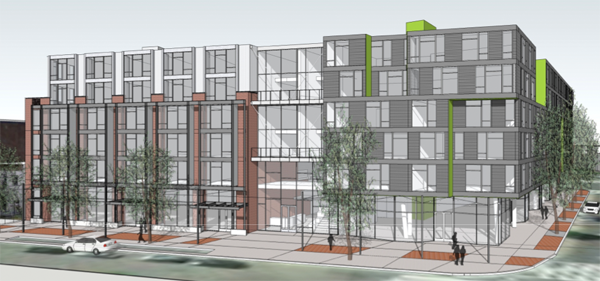
Looking west from 8th Street
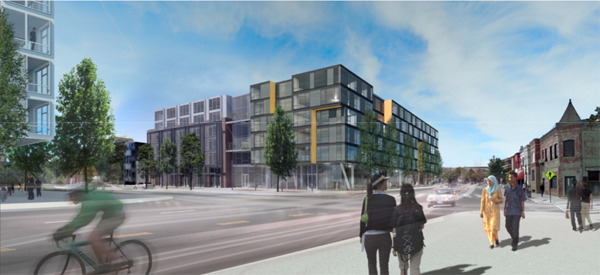
Looking southwest from Florida Avenue
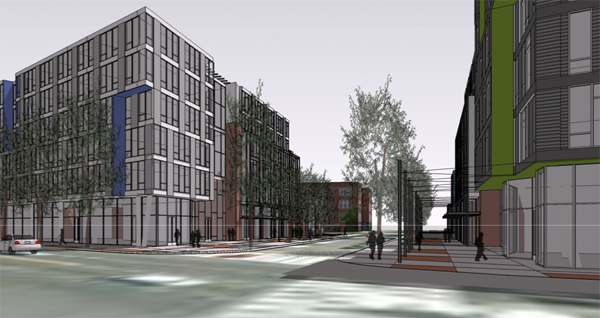
Looking south along 8th Street from Florida Avenue
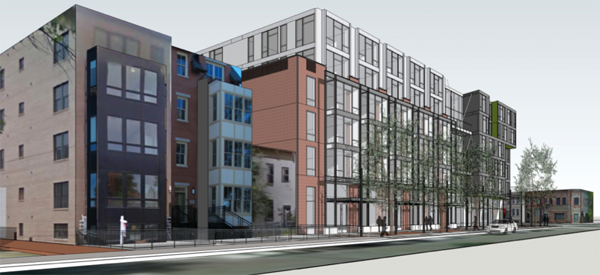
Looking northwest along 8th Street
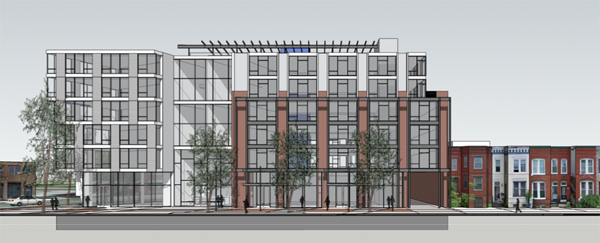
Looking east from 8th Street
Howard Theatre encourages private parking
To reduce the liklihood that patrons will park on residential streets around the Howard Theatre, the theatre will sell prepaid private parking through Ticketmaster. The passes are for private lots owned by Howard University and other private owners.
In fact, we were looking on Ticketmaster at prices and availability for April’s Wanda Sykes show and spotted this prominent parking add-on at the bottom:

The lots described above are as follows:
- Valet shuttle Lot B – Howard University’s large parking lot at Georgia Avenue and W Street.
- Self-parking Lot A – Howard University’s HURB-I parking lot at 7th & T Streets.
- Premier Valet – private triangle lot at T Street and Florida Avenue, across from the theater.
When Progression Place, the office and apartment project at the Shaw Metro, finally opens, the theatre will lay claim to a significant number of the project’s underground parking spaces during nighttime hours, thus adding a another option.
Meet Eleanor Holmes Norton in LeDroit Park on Tuesday
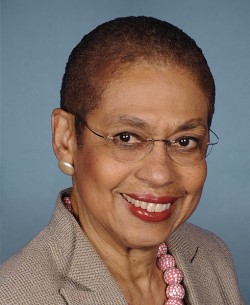 Come meet Del. Eleanor Holmes Norton (D – DC) at Tuesday’s meeting of the LeDroit Park Civic Association. The meeting will be on Tuesday, March 27 at 7 pm at the Florida Avenue Baptist Church (enter at U and Bohrer Streets NW).
Come meet Del. Eleanor Holmes Norton (D – DC) at Tuesday’s meeting of the LeDroit Park Civic Association. The meeting will be on Tuesday, March 27 at 7 pm at the Florida Avenue Baptist Church (enter at U and Bohrer Streets NW).
Ms. Norton is this month’s guest speaker. We’re inclined to ask her about National Park Service (NPS) stewardship of the many parks and reservations in DC. The NPS runs Logan Circle, Dupont Circle, Farragut Square, and other parks within the L’Enfant Plan, but does a poor job of programming and managing these parks.
We will also hav e representatives from Progression Place, the construction site at the Shaw Metro, update us on the progress of their project.
Food may return to the Wonderbread Factory next year
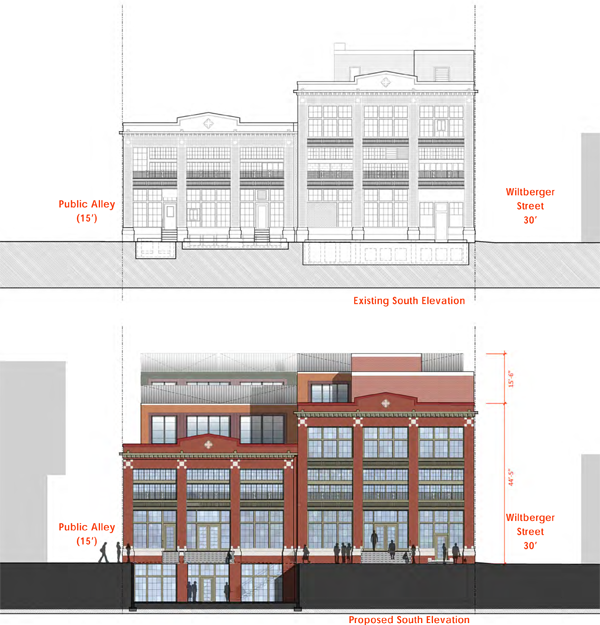
Plans for the dilapidated Wonderbread Factory are moving along. Last night at the ANC 1B Design Review Committee we heard representative from Douglas Development Corporation share their latest plans for the Wonderbread Factory at 621 S St NW.
Though apartment projects are the hot thing in Washington real estate right now, Douglas is sticking with its usual market of commercial tenant space. Their latest plan for the Wonderbread Factory includes a ground floor and basement floor for retail space, which they imagine may include restaurants or a microbrewery. The upper floors will include loft-like office space.
They are setting an agressive timeline to have the project finished in the spring of 2013 and they say they have had numerous inquiries about the space, especially from restaurateurs.
We first encountered Douglas Development’s proposal several months ago when the company had more rudimentary drawings for the site. The building, known as the Wonderbread Factory, is now under local historic preservation protection and Douglas Development has produced the latest renderings based on feedback from the Historic Preservation Review Board and the staff at the Historic Preservation Office. The designs are quite impressive.
Eastern elevation along Wiltberger Street (before and after):
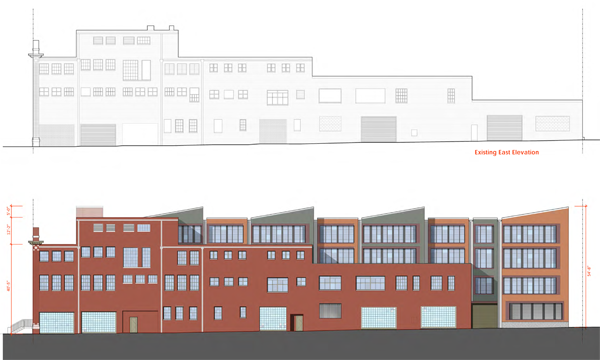
Western elevation along the alley between the site and Progression place (before and after):
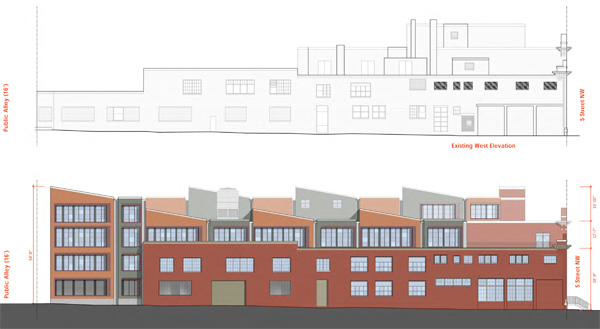
Rendering of what the front will look like:

Renderings of what the rear (northern end) will look like form Wiltberger Street and from the alley:
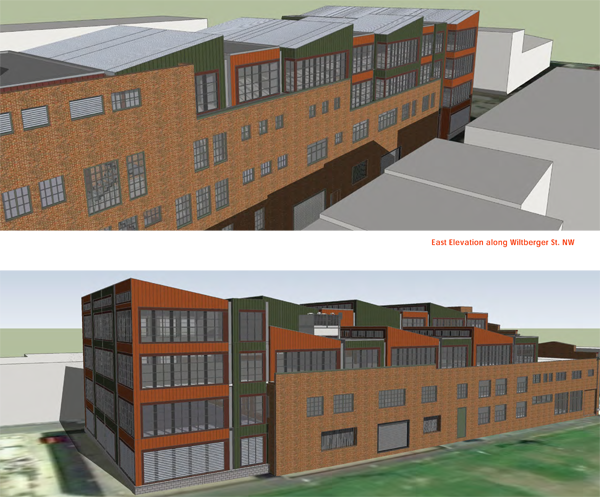
Rendering of what the new rear will look like:
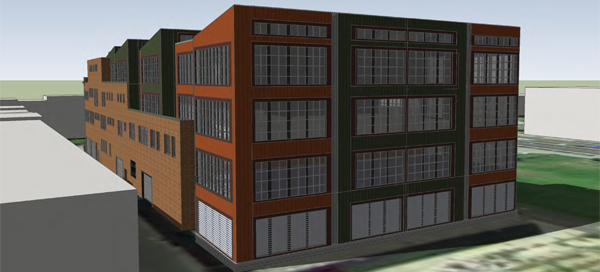
Rear (northern) façade before and after:
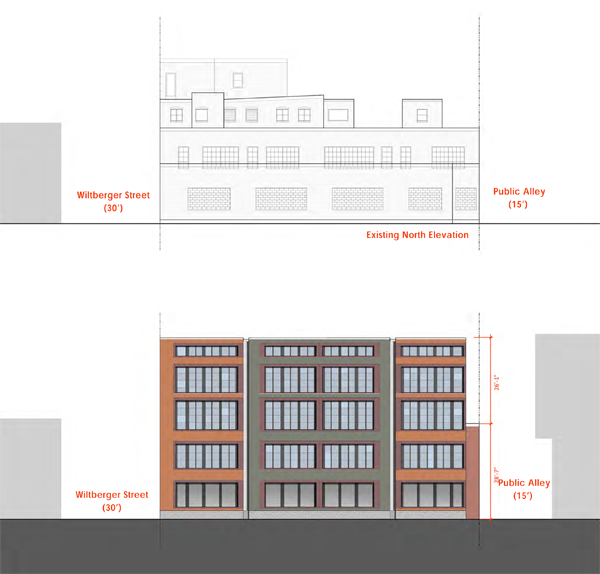
[Update: I have added wording and link to note that the building is in the DC Inventory of Historic Sites, though it does not yet appear to be in the National Register of Historic Places]
Howard Theatre ribbon-cutting set for April 9
The Howard Theatre developers want the new interior to come as a surprise on opening day, so they are not letting people take photographs inside right now. Nonetheless, the City Paper described it as “opulent”.
The ribbon-cutting, which is open to the public, will be on Monday, April 9 from 11:30 am to 3 pm. You can get a tour of the theater and witness the unveiling of the Duke Ellington statue for the plaza and the “Jazz Man” sculpture on the cornice.



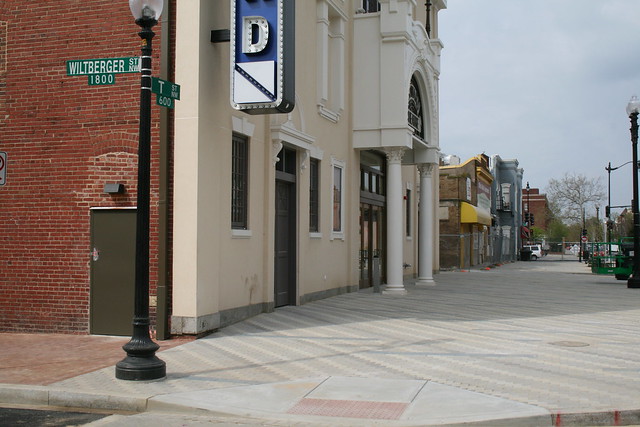
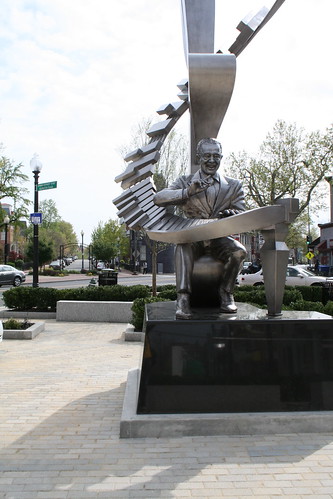
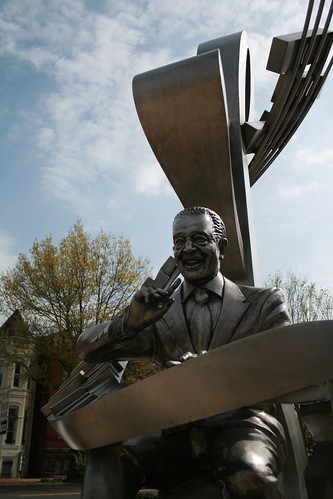
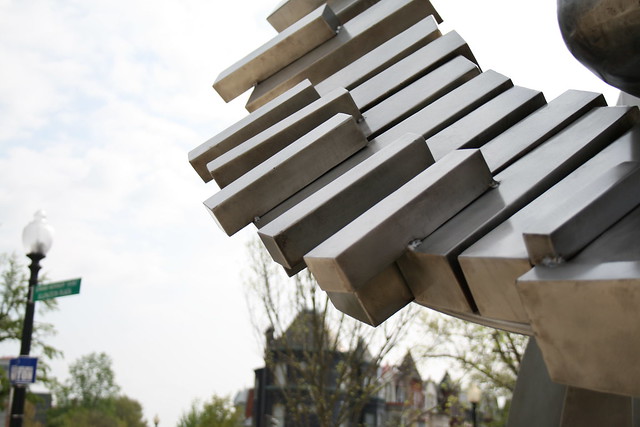
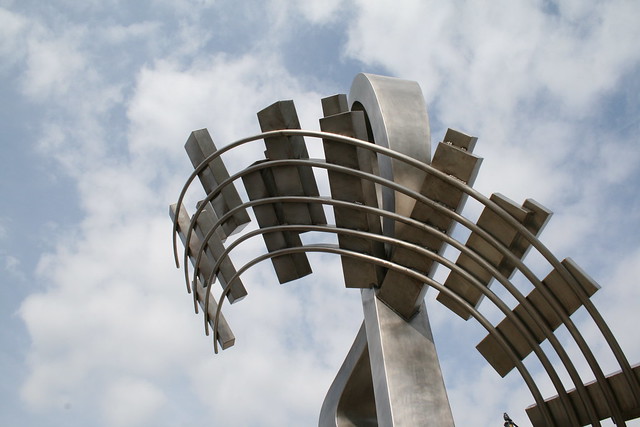







Recent Comments